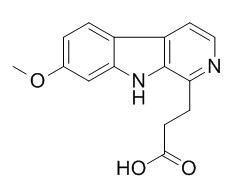7-Methoxy-beta-carboline-1-propionic acid
7-Methoxy-beta-carboline-1-propionic acid demonstrates significant antimalarial activity as judged by studies conducted with cultured Plasmodium falciparum strains.
Inquire / Order:
manager@chemfaces.com
Technical Inquiries:
service@chemfaces.com
Tel:
+86-27-84237783
Fax:
+86-27-84254680
Address:
1 Building, No. 83, CheCheng Rd., Wuhan Economic and Technological Development Zone, Wuhan, Hubei 430056, PRC
Providing storage is as stated on the product vial and the vial is kept tightly sealed, the product can be stored for up to
24 months(2-8C).
Wherever possible, you should prepare and use solutions on the same day. However, if you need to make up stock solutions in advance, we recommend that you store the solution as aliquots in tightly sealed vials at -20C. Generally, these will be useable for up to two weeks. Before use, and prior to opening the vial we recommend that you allow your product to equilibrate to room temperature for at least 1 hour.
Need more advice on solubility, usage and handling? Please email to: service@chemfaces.com
The packaging of the product may have turned upside down during transportation, resulting in the natural compounds adhering to the neck or cap of the vial. take the vial out of its packaging and gently shake to let the compounds fall to the bottom of the vial. for liquid products, centrifuge at 200-500 RPM to gather the liquid at the bottom of the vial. try to avoid loss or contamination during handling.
Int J Mol Sci.2021, 22(11):5503.
ACS Omega.2022, 7(44):40009-40020.
Pharmacognosy Journal, 2021, 13(5).
Int. J. Mol. Sci.2022, 23(14),7699;
Evid Based Complement Alternat Med.2020, 2020:9416962.
Evid Based Complement Alternat Med.2020, 2020:8582318.
Food Chem.2023, 424:136383.
Foods.2023, 12(6):1227.
Separations2023, 10(4), 231.
PLoS One.2018, 13(3):e0193386
Related and Featured Products
J Nat Prod. 1991 Sep-Oct;54(5):1360-7.
Cytotoxic and antimalarial constituents of the roots of Eurycoma longifolia.[Pubmed:
1800638]
METHODS AND RESULTS:
By bioactivity-directed fractionation, five cytotoxic constituents have been characterized from the roots of Eurycoma longifolia collected in Kalimantan, Indonesia. Four canthin-6-one alkaloids, namely, 9-methoxycanthin-6-one, 9-methoxycanthin-6-one-N-oxide, 9-hydroxycanthin-6-one, and 9-hydroxycanthin-6-one-N-oxide, and one quassinoid, eurycomanone, were found to be cytotoxic principles. Each of these compounds was evaluated against a panel of cell lines comprising a number of human cancer cell types [breast, colon, fibrosarcoma, lung, melanoma, KB, and KB-V1 (a multi-drug resistant cell line derived from KB)] and murine lymphocytic leukemia (P-388).
The canthin-6-ones 1-4 were found to be active with all cell lines tested except for the KB-V1 cell line.
CONCLUSIONS:
Eurycomanone was inactive against murine lymphocytic leukemia (P-388) but was significantly active against the human cell lines tested.
Two additional isolates, the beta-carboline alkaloids beta-carboline-1-propionic acid and 7-Methoxy-beta-carboline-1-propionic acid, were not significantly active with these cultured cells. However, compounds 5 and 7 were found to demonstrate significant antimalarial activity as judged by studies conducted with cultured Plasmodium falciparum strains. The structures of the novel compounds 2-4 and 7 were established by spectral and chemical methods.



